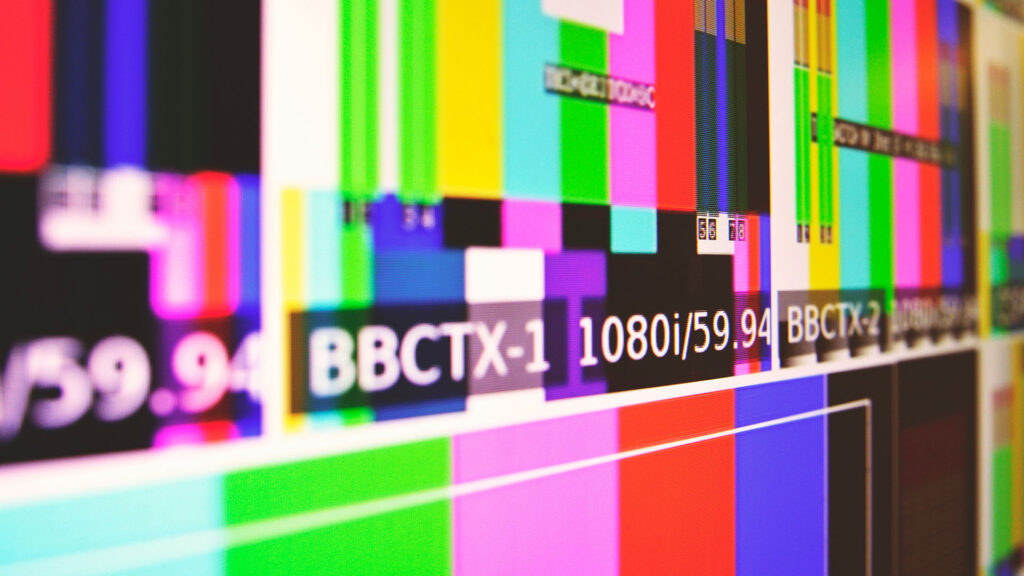
HD SMPTE Color Bars With Tone – Free Download
I quickly generated this color bars test pattern for a recent video project. It may not be 100% accurate but it looks professional enough! Feel free to download it using the link at the bottom of this page.
Originating in the 1970s, the SMPTE color bars is a standard test pattern, utilised by video engineers, to conform multiple sources of video content to a single specification. The pattern can also be used to calibrate chroma and luminance values on video monitors.
Understanding the SMPTE Color Bars: A Guide to Video Calibration
In the world of video production, quality and accuracy are paramount. Ensuring that the colors, tones, and levels in your video are calibrated correctly is crucial for delivering a professional and visually appealing product. One tool that has been a staple in video calibration for decades is the SMPTE color bars.
What are SMPTE Color Bars?
The Society of Motion Picture and Television Engineers (SMPTE) color bars is a standardized test pattern used to calibrate and assess the quality of video signals. These color bars are a series of vertical bars that display specific colors and tones, serving as a reference for video engineers, editors, and broadcasters.

Components of SMPTE Color Bars:
- White (100 IRE): The first bar represents pure white, with a luminance level of 100 IRE (Institute of Radio Engineers units). This bar helps calibrate the brightness of a display.
- Yellow (75 IRE): The second bar is yellow, with a luminance level of 75 IRE. It is used to set the proper contrast levels.
- Cyan (56.25 IRE): The third bar is cyan, with a luminance level of 56.25 IRE. It aids in adjusting the color saturation.
- Green (43.75 IRE): The fourth bar is green, with a luminance level of 43.75 IRE. It is another reference for color saturation and brightness.
- Magenta (31.25 IRE): The fifth bar is magenta, with a luminance level of 31.25 IRE. It helps in fine-tuning the color balance.
- Red (18.75 IRE): The sixth bar is red, with a luminance level of 18.75 IRE. It is useful for adjusting color saturation and brightness.
- Blue (6.25 IRE): The seventh bar is blue, with a luminance level of 6.25 IRE. It assists in balancing color saturation and brightness.
- Black (0 IRE): The eighth bar represents pure black, with a luminance level of 0 IRE. It is crucial for adjusting the black level of a display.
Why Use SMPTE Color Bars?
- Calibration and Setup: SMPTE color bars serve as a reference for calibrating monitors, cameras, and other video equipment. By adjusting the settings to match the colors and levels in the SMPTE pattern, video professionals can ensure that their equipment is set up correctly for accurate color reproduction.
- Transmission Quality: In broadcasting, SMPTE color bars are often used to evaluate the quality of video transmission. By analyzing the received color bars, broadcasters can identify issues such as color shifts, hue variations, and other discrepancies that may affect the viewing experience for the audience.
- Content Creation: Video editors and content creators use SMPTE color bars during the post-production phase to maintain color consistency across different scenes and shots. This is particularly important when working on projects that involve multiple cameras or various lighting conditions.
- Standardization: The use of SMPTE color bars establishes a standardized color reference across the industry. This ensures that content produced by different professionals and organizations adheres to a common color standard, facilitating seamless integration and exchange of video material.

Practical Application:
To utilize SMPTE color bars effectively, video professionals follow a standardized calibration process. This involves adjusting parameters such as brightness, contrast, saturation, and hue to match the reference colors and levels in the SMPTE pattern.
Additionally, waveform monitors and vectorscopes are commonly used in conjunction with SMPTE color bars for a more detailed analysis of color signals and luminance levels.










